You are here
A Look at the Competing House and Senate Budget Proposals
In the last week, the House Republicans and the Senate Democrats have each introduced budget proposals for the coming decade. The proposals1 present distinct visions of the role of the federal government in our economy. Both highlight trillions of dollars of deficit reduction, though the timing and amounts differ substantially.
The House Republicans cut spending quickly, bringing deficits below one percent of GDP by 2015 and balancing the budget by the end of the decade. Their deficit-reduction plan relies entirely on spending cuts, with nearly half of these cuts coming from health care programs, including the repeal of the 2010 health reform law. They cap the growth of Medicaid spending and make reductions in other programs. They also propose a major reform for Medicare, but it wouldn’t produce significant budgetary savings until after 2023.
The Senate Democrats propose more modest deficit reduction composed of both spending cuts and tax increases, and put the debt on a downward path by the end of the decade. Senate Democrats propose $100 billion in additional stimulus spending in the short term, which increases deficits in 2013 and 2014. But the cumulative effect of higher taxes and reduced defense spending lowers deficits in later years.
Compared to the House, the Senate would raise $975 billion more in revenues and spend nearly $4.9 trillion more over the next 10 years. Most of that spending difference would be in health care, but the Senate mark also includes $1 trillion more for non-defense discretionary programs.
In the charts below, we focus on budget trends over the coming decade under the House Republican and Senate Democrat proposals. However, we should keep in mind that a 10-year perspective is not long enough. The real fiscal challenge facing the nation will become evident in the subsequent decade, as the baby boomers retire in large numbers and health care costs continue to grow.
Figure 1: Deficits
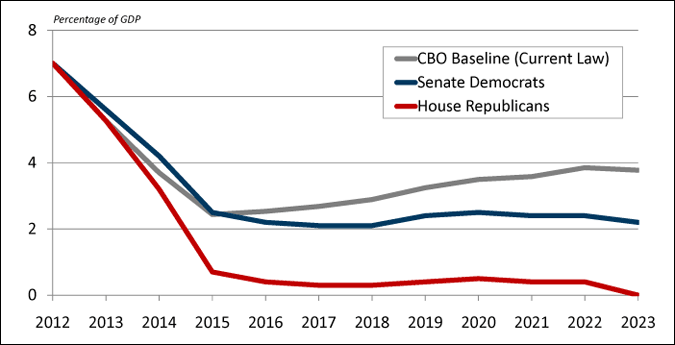
SOURCE: Data from the House Budget Committee, The Path to Prosperity: A Responsible, Balanced Budget, March 2013; Senate Budget Committee, Foundation for Growth: Restoring the Promise of American Opportunity, March 2013; and the Congressional Budget Office, The Budget and Economic Outlook: Fiscal Years 2013 to 2023, February 2013. Compiled by PGPF.
Figure 2: Debt held by the public
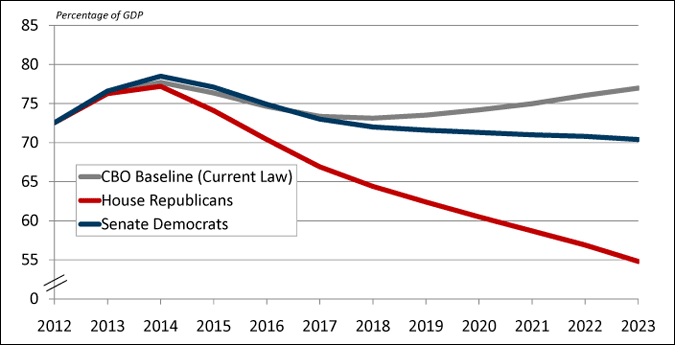
SOURCE: Data from the House Budget Committee, The Path to Prosperity: A Responsible, Balanced Budget, March 2013; Senate Budget Committee, Foundation for Growth: Restoring the Promise of American Opportunity, March 2013; and the Congressional Budget Office, The Budget and Economic Outlook: Fiscal Years 2013 to 2023, February 2013. Compiled by PGPF.
Figure 3: Comparison of budget plans
Percentage of GDP
| 2012 | 2023 | |||
| Actuals |
CBO Baseline (Current Law) |
House Republicans |
Senate Democrats |
|
|---|---|---|---|---|
| Revenues | 15.8 | 19.1 | 19.1 | 19.8 |
| Outlays | 22.8 | 22.9 | 19.1 | 21.9 |
| Deficits | 7.0 | 3.8 | 0.0 | 2.2 |
| Debt | 72.5 | 77.0 | 54.8 | 70.4 |
SOURCE: Data from the House Budget Committee, The Path to Prosperity: A Responsible, Balanced Budget, March 2013; Senate Budget Committee, Foundation for Growth: Restoring the Promise of American Opportunity, March 2013; and the Congressional Budget Office, The Budget and Economic Outlook: Fiscal Years 2013 to 2023, February 2013. Compiled by PGPF.
Figure 4: Revenues
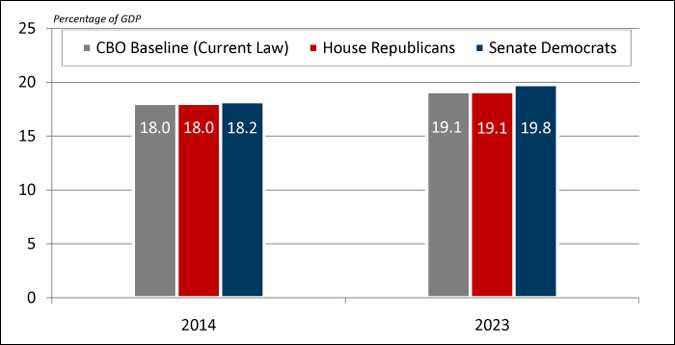
SOURCE: Data from the House Budget Committee, The Path to Prosperity: A Responsible, Balanced Budget, March 2013; Senate Budget Committee, Foundation for Growth: Restoring the Promise of American Opportunity, March 2013; and the Congressional Budget Office, The Budget and Economic Outlook: Fiscal Years 2013 to 2023, February 2013. Compiled by PGPF.
Figure 5: Total spending
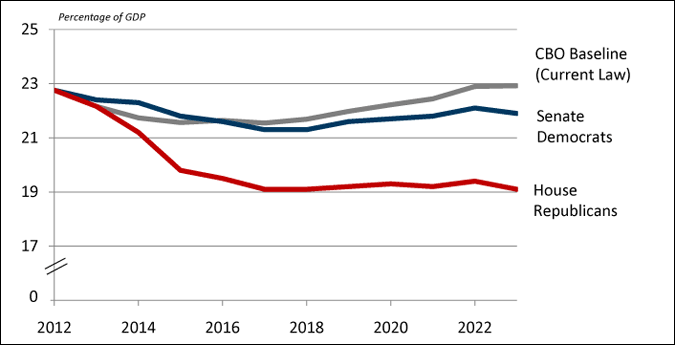
SOURCE: Data from the House Budget Committee, The Path to Prosperity: A Responsible, Balanced Budget, March 2013; Senate Budget Committee, Foundation for Growth: Restoring the Promise of American Opportunity, March 2013; and the Congressional Budget Office, The Budget and Economic Outlook: Fiscal Years 2013 to 2023, February 2013. Compiled by PGPF.
Figure 6: Defense spending
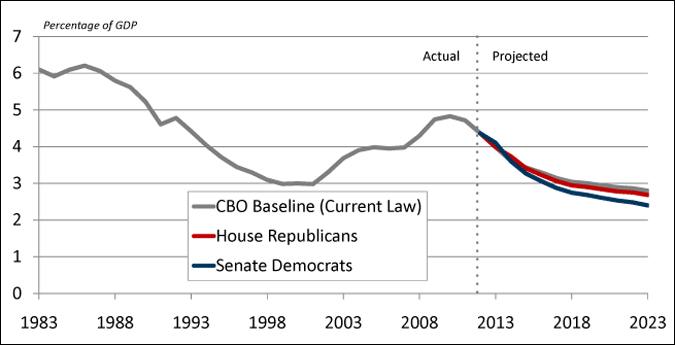
SOURCE: Data derived from the House Budget Committee, The Path to Prosperity: A Responsible, Balanced Budget, March 2013; SenateBudget Committee, Foundation for Growth: Restoring the Promise of American Opportunity, March 2013; and the Congressional Budget Office, The Budget and Economic Outlook: Fiscal Years 2013 to 2023, February 2013. Calculated by PGPF.
NOTE: Defense outlays include both mandatory and discretionary spending, as well as PGPF's estimate of the Defense Department's share of function 970 (Global War on Terror).
Figure 7: Discretionary spending
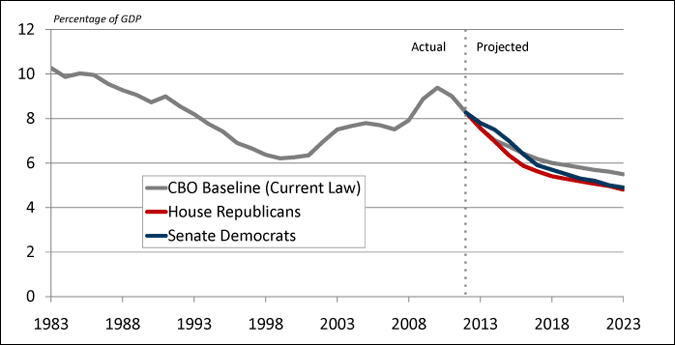
SOURCE: Data derived from the House Budget Committee, The Path to Prosperity: A Responsible, Balanced Budget, March 2013; SenateBudget Committee, Foundation for Growth: Restoring the Promise of American Opportunity, March 2013; and the Congressional Budget Office, The Budget and Economic Outlook: Fiscal Years 2013 to 2023, February 2013. Compiled by PGPF.
Figure 8: Medicaid and other health spending (excluding Medicare)
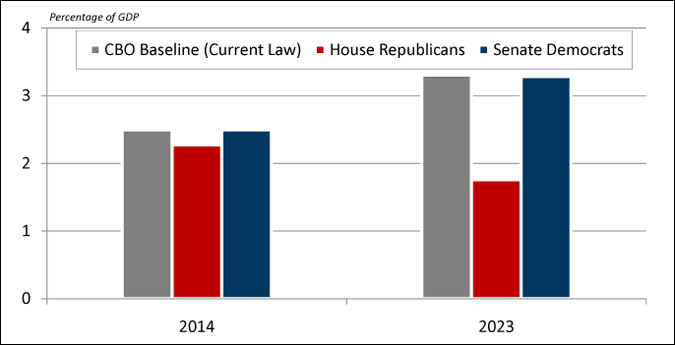
SOURCE: Data from the House Budget Committee, The Path to Prosperity: A Responsible, Balanced Budget, March 2013; Senate Budget Committee, Foundation for Growth: Restoring the Promise of American Opportunity, March 2013; and the Congressional Budget Office,The Budget and Economic Outlook: Fiscal Years 2013 to 2023, February 2013. Compiled by PGPF.
NOTE: Spending levels include both mandatory and discretionary outlays for budget function 550.
1This analysis is based upon the "Chairman’s Marks" — or the budgets introduced by the Chairmen of the Budget Committees of each house. These documents are subject to amendment in Committee and on the floor as they proceed through the legislative process. If the House and the Senate agree on a budget resolution, that congressional budget would not be enacted into law, but would guide the Congress' subsequent work on appropriation, tax and entitlement legislation.
